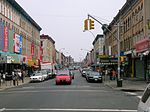Search results
Appearance
There is a page named "Ladies and Gentlemen, the Bronx Is Burning" on Wikipedia
- Ladies and Gentlemen, the Bronx Is Burning: 1977, Baseball, Politics, and the Battle for the Soul of a City is a book by Jonathan Mahler that focuses on...15 KB (1,830 words) - 22:51, 26 September 2024
- Hamlet on the Hudson)book Ladies and Gentlemen, the Bronx Is Burning. In 1978, incumbent lieutenant governor Krupsak declined to seek re-election. She withdrew from the ticket...62 KB (6,560 words) - 20:45, 3 April 2025
- The Son of Sam)21, 2006). Ladies and Gentlemen, the Bronx is Burning: 1977, Baseball, Politics, and the Battle for the Soul of a City. Farrar, Straus and Giroux. ISBN 978-1429931038...95 KB (11,101 words) - 21:48, 31 March 2025constitute 'perhaps the toughest square mile in the city.'"" Mahler, Jonathan (2005). Ladies and Gentlemen, the Bronx is Burning. Farrar, Straus and Giroux. ISBN 0-312-42430-2...204 KB (21,042 words) - 20:07, 3 April 2025Reggie Jackson (category Short description is different from Wikidata)Ladies and Gentlemen, the Bronx is Burning. Picador. pp. 154–155. ISBN 978-0-312-42430-5. He often wore Gloria Vanderbilt Jeans, a Polo shirt and loafers...89 KB (10,541 words) - 13:44, 26 March 2025Bella Abzug (category Politicians from the Bronx)Ladies and gentlemen, the Bronx is burning : 1977, baseball, politics, and the battle for the soul of a city (1st ed.). New York: Farrar, Straus and Giroux...42 KB (4,130 words) - 22:26, 24 March 2025(category Template:Succession box: 'after' parameter includes the word 'abolished')Ladies and gentlemen, the Bronx is burning: 1977, baseball, politics, and the battle for the soul of a city (1st ed.). New York: Farrar, Straus and Giroux...18 KB (1,685 words) - 00:37, 4 April 2025
- The New York blackout)ISSN 0018-9235. Mahler, Jonathan (2005). Ladies and Gentlemen, The Bronx is Burning. New York: Farrar, Straus and Giroux. ISBN 9780374175283. "New York Blackout...27 KB (3,270 words) - 03:24, 9 March 2025
- 1977 New York Yankees season (category 1970s in the Bronx)televised Game of the Week. Jonathan Mahler wrote a bestselling book entitled Ladies and Gentlemen, The Bronx Is Burning about the turmoil in New York...72 KB (1,470 words) - 23:13, 3 April 2025
- Baseball portal Ladies and Gentlemen, The Bronx Is Burning The Yankee Years "The Bronx Zoo, 30 Years Later – The New York Sun". Nysun.com. July 5, 2007....6 KB (517 words) - 15:55, 29 September 2024
- Bushwick, Brooklyn (category Hispanic and Latino American culture in New York City)described the social and economic hardships of Bushwick after the blackout in his book Ladies and Gentlemen, the Bronx is Burning, explaining that the majority...111 KB (11,699 words) - 18:18, 11 March 2025
- Rotonda West, Florida (category Short description is different from Wikidata)Ladies and gentlemen, the Bronx is burning : 1977, baseball, politics, and the battle for the soul of a city (1st ed.). New York: Farrar, Straus and Giroux...20 KB (1,809 words) - 04:23, 10 March 2025
- Timeline of New York City events, crimes and disasters)October 12: "Ladies and gentlemen, the Bronx is burning." During Game 2 of the 1977 World Series between the New York Yankees and the Los Angeles Dodgers...216 KB (23,225 words) - 21:39, 27 March 2025
- History of The MLB on ABC)it is, ladies and gentlemen, The Bronx is burning." This was later picked up by candidate Ronald Reagan, who then made a special trip to the Bronx, to...167 KB (18,129 words) - 03:40, 21 February 2025Michael R. Long (category Candidates in the 1966 United States elections)mentioned in the book Ladies and Gentlemen, The Bronx Is Burning, which documents the 1977 New York City mayoral election; the first edition of the book accused...11 KB (775 words) - 00:32, 3 December 2024(category University of Michigan College of Literature, Science, and the Arts alumni)Ladies and gentlemen, the Bronx is burning : 1977, baseball, politics, and the battle for the soul of a city (1st ed.). New York: Farrar, Straus and Giroux...26 KB (2,862 words) - 01:09, 22 February 2025
- is an American television and radio sports broadcaster, perhaps best known as a local news sports anchor in Washington, D.C., and New York City, and for...12 KB (1,471 words) - 17:10, 15 March 2025
- captain and resident of the mid-1600s. Ladies and Gentlemen, the Bronx Is Burning. Jonathan Mahler, title of book My name is Benny Blanco from the Bronx. -
- had packed his poke with paper and sent him on a tour of the country. Because of the travel thing nobody around the Bronx had seen or heard from him more








